Introduction
The key idea of this paper is to carry out a thorough research regarding Marks & Spencer, one of the leading retailers of the UK. In order to do so, it will address a number of issues, such as, M&S’s challenges for the last few years, the retail trends in the UK in 2011, current performance of M&S in contrast to consumer confidence in the UK, customer segmentation profile, and suggestions on optimum customer segments for promoting products of the company.
Moreover, this paper will concentrate on the validation of the suggestions in context to relevant theories and models in the latter parts of the paper. Conversely, the paper will guide the company’s Director of Information Technology department about the way in which the website of M&S should construct to increasing number of customers and generating more turnover.
Marks & Spencer’s Challenges for the Last Few Years
According to Reuters (2011), M&S is a UK based retail business, which consists more than 21m regular consumers every week; it sells a wide range of fashionable clothing, foodstuffs, and wines; moreover, it has 703 stores throughout the UK and 361 stores throughout Europe, Middle East, and Asia; it is notable that 51% of the business deals with grocery. The following figure shows the organisational chart of the retailer:
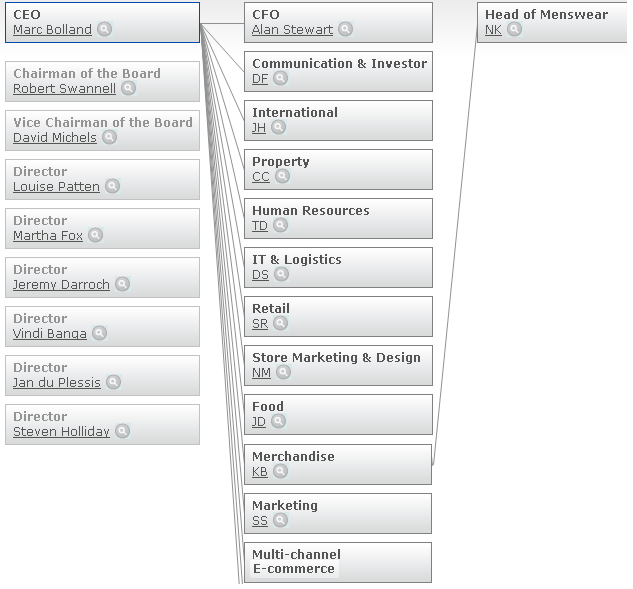
However, Marks & Spencer has suffered from the severe impacts of the global economic downturn in terms of falling financial performance and lowering purchasing powers of consumers. The basic chart of the company suggests how seriously the drop in demand and the resulting decline in the sales have influenced the share prices of the company in 2009:
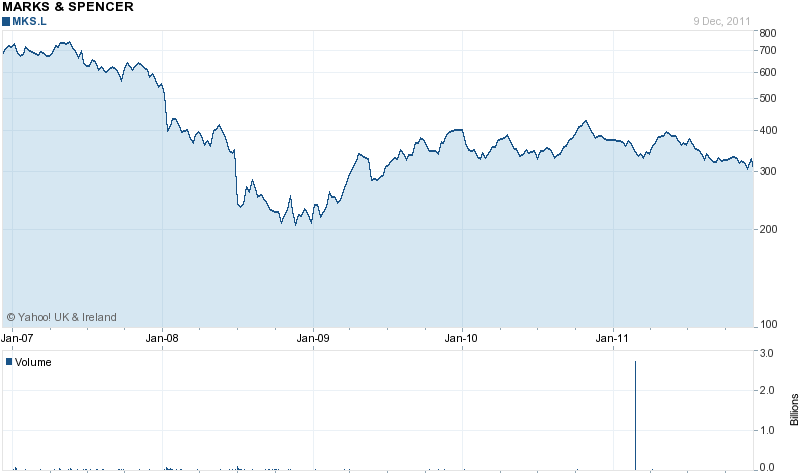
These universal business challenges were widespread in the organisation; for example, according to a report of The Telegraph, in August 2008, the retailer possessed 11.4% market share of the girls’ clothing market, whilst during the same period of 2007 this figure was 13.7%; moreover, the market share of the entire business fell from 11.7% to 9.8% (Rayner, 2008). This indicates the fact that it is extremely crucial for businesses to identify new methods to retain consumers not only in a booming economic condition, but also during adverse business environments through attempts like consumer behaviour analysis and marketing research.
The Retail Trends in the UK in 2011
Graduate Prospects Ltd (2011) suggested that the industry is set to amplify in size by 15 percent over the next five years, taking its value to just over £312bn; nevertheless, this indicates sluggish yearly growth with operating costs, and cost of credit set to rise, so, retail-sector will confront challenging times; companies who cannot compete against shrinking margins will suffer. The electrical-sector is presently the top performer, with an expansion of 24 percent; whereas the grocery sector confronts a hard time due to falling consumer confidence in the country; the reason behind this declining spending is mainly due to consumer debt, rising interest rates, inflation, home prices, and job security, for which they are nervous about their own financial security.
Current Performance of M&S in Contrast to Consumer Confidence in UK
In spite of the fact that recessional after effects are still present to some extent, the current performance of M&S are showing optimistic trends, as shown in the chart below. However, although the group revenues are showing increasing trends, the profits are still lower than the past financial year and the financial year 2007.
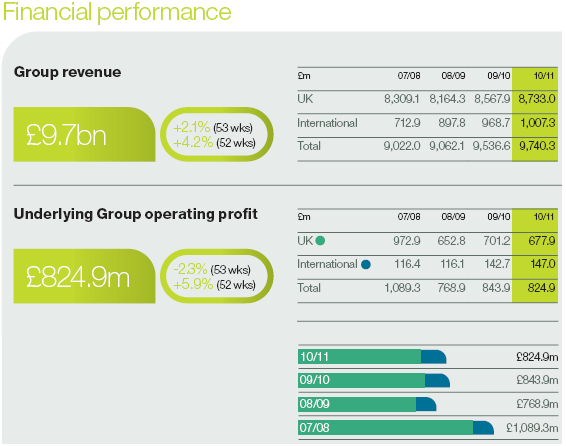
Nevertheless, for the UK retail industry, consumer confidence stayed brittle for financial year 2010 to 2011; following a sharp slowdown and then recovery during 2009, confidence levels have oscillated over the past twelve months; this was accelerated by a prevailing sense of insecurity; conversely, from 2011, consumers became increasingly cautious about economic-outlook considering new government’s spending-cuts, VAT-increases and rising fuel-prices:

In the pace of falling consumer confidence, it is essential for the company to undertake a number of fresh strategies for the optimum customer segments to promote its products, so that even in such a fragile economic environment, a constant flow of income exists for M&S; some of the strategies are suggested in the latter parts of the paper.
However, meanwhile, M&S has constructed some SMART objectives for the future in terms of growth and business expansion, as shown in the figure below:
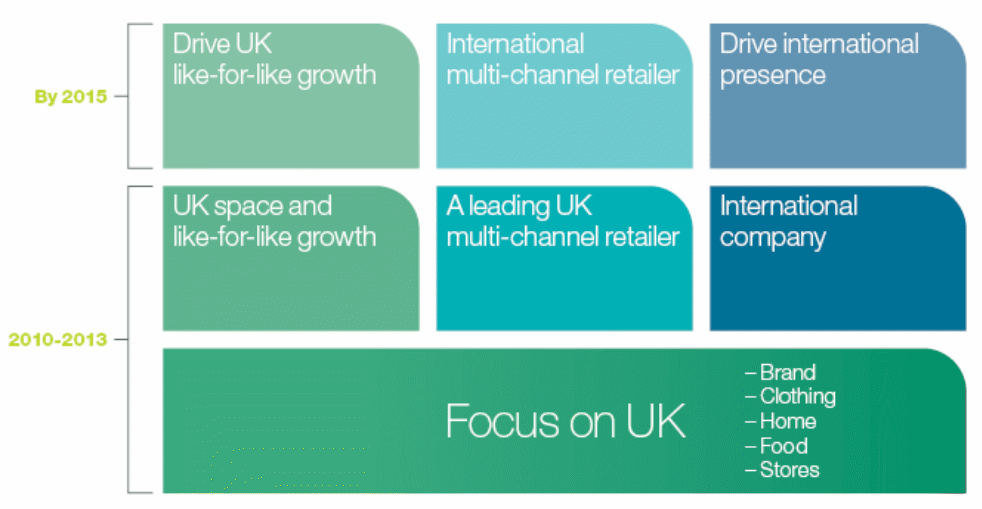
It is arguable that although the SMART objectives seem quite impressive, a focus on managing the customer base efficiently is far more important for M&S because another financial downturn may hit the market as a consequent effect of the Euro zone crisis.
Customer Segmentation Profile of M&S
According to House (2011), there is huge dissimilarity between the first time customers and current customers of Marks & Spencer plc. Initially, it was a very small-scale business with a few numbers of customers visiting its stores. Most importantly, it offered limited number of products, for which the customer base was small as well. House (2011) also pointed out that as a century old business; Marks & Spencer plc has gone through a number of changes not only in its organisational structure or operations, but also in the products and services being offered; as a result, the customer base has changed widely through years.
However, today, the customer segmentation of the company is much more organized; the purchasers of the company includes customers of women’s wear, lingerie, men’s wear, kid’s wear, furniture, flowers, gifts, wine, home ware, food and groceries, which consist of freshly produced items as well as partially cooked meals, fully cooked meals and so on. This diversified and enormous target market means that the different departments of the company needs to focus vastly on the trends, characteristics, demands, feedback, likes, and dislikes of the particular customer groups.
Marks & Spencer (2011), Williamson (2006), and House (2011) indicated that the key customers of the business are individuals, families, and institutions. To specify, individual customers are present to buy stuffs such as women’s wear, lingerie, men’s wear, flowers, gifts, wine, etc; conversely, families also purchase these products; in addition, the families also purchase items like home ware, kid’s wear, furniture, food and groceries, partially cooked meals, fully cooked meals, etc.
Moreover, institutions are also the customers of the business; for example, small- scale neighbourhood shops in the UK buy products from M&S in bulk. In some cases, while delivering products to customers in such a foreign country where it do not have any operations, an institution usually acts as a primary customer. It is important to state that as a player of the consumer market, M&S follows the segmentation criteria shown below:
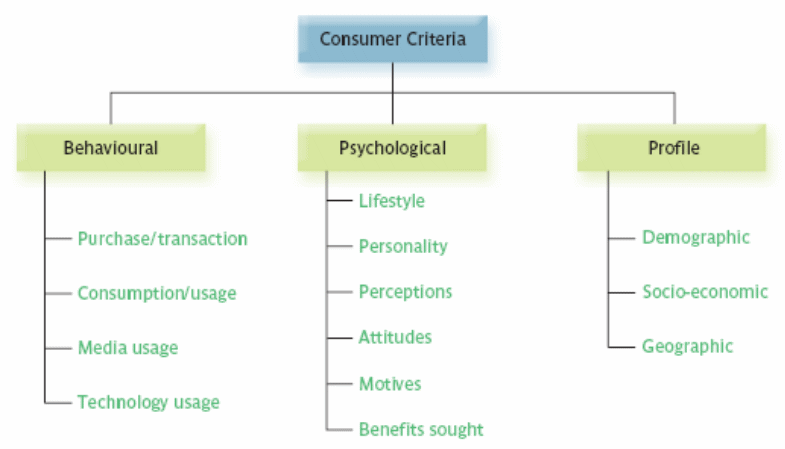
As stated earlier, M&S possess a diversified range of customers; this is because people of all ages and gender shop from here; for example, apart from women’s wear and lingerie, men’s wear is also found here. In addition, the young customers of the company comes to the stores to buy gifts and kid’s wear, youthful women and men come to buy flowers, wine, and outfits, whereas middle aged of old people come to make purchases of home ware, furniture, food and groceries; nevertheless, Ayub (2011) argues that middle-aged female generate some income for M&S.
However, the customer segmentation of this retailer of the UK do not include low income earners in its list, as the features of its operations are only focusing on higher and middle income earners (Ries & Trout, 1972 and Ayub, 2011). Marks & Spencer (2011) states that the cultures of the customer groups are diversified as well; this is because all the residents of the UK shop from here irrespective of their religion, race, nationality, gender, tradition, and ethnicity.
Suggestions on Optimum Customer Segments for Promoting Products
In order to sustain in this slow growth economy, where a number of risks of market failures exist alongside the fear of one more recession that may result from the Euro zone crisis, it is highly essential for the Marks and Spencer to focus on promoting its products further. This is important not only to attract the targeted customer segments of Marks and Spencer, but also to keep up their loyalty through different methods or promotional approaches during tough circumstances.
For preserving a loyal customer base for a long time, a number of suggestions can be put forward. For example, depending on the type of festival or occasion, M&S could set its special promotional offers; for instance, special packages that include extremely attractive discount-vouchers, M&S promotional-codes, money-off coupon codes for great discounts, and many other packages for individual and family clients.
This makes sense because the good portion of M&S’s customers are youths, and they always want to shop more for their friends and spouses on festive seasons like Valentine’s Day, New Year’s Eve, or Christmas. Through setting an attractive range of discount packages the company will not only be able to boost sales in short-term, but it will have a huge impact over the long-term relations with the customers, as they will always remember the experience of buying good quality products on cheaper prices.
This will influence them to make purchases from M&S during not only the discount offers, but also when the discounts will be lifted because good quality products are always tempting to people; in addition, it is notable that the prices charged by this UK retailer is quite reasonable. These offers will help the company to gain competitive advantage over the competitors by augmenting sales during these special periods of the year. These sales discounts will be viable for the company, as middle-income earners account to a large portion of its targeted segment.
The promotional strategies of M&S would vary accordingly with the changing consumer trends, demands, and other external circumstances. The discount vouchers offered will vary for different customers because M&S’s strategy would be to set more discounts for the loyal customers and local residents rather than the seasonal customers whose aim merely remains on gaining an advantage of the discount coupons. This strategy will benefit the company by generating an interest among the new customers for being loyal in order to gain full advantage of the promotional packages, which in turn, would raise the profit margins of the company jointly with the advertising campaigns.
Conversely, as a large portion of M&S’s business deals with women clothing industry, it will have to focus on promotions through advertising as well. It is notable that this particular industry is highly competitive and to keep up the market share for long-term, it is viable for the business to attract more women by advertising in those media, which are mostly viewed by the women, who are the targeted customer segments of the company.
Therefore, focusing on the fact the M&S needs to construct long-term relationship with the customers for performing constantly throughout adverse business environments, an important idea for it is to invest heavily on celebrity endorsements through advertisements in TV. This will create perceived differentiation for the company and attach a sense of authenticity to the company’s clothing. Some authors have suggested that people, in certain circumstances, not only love to buy only the product, but also the reputation and brand awareness that comes along with it. Undoubtedly, strong brand awareness would result in increasing sales for Marks and Spencer.
In addition, it is necessary for the M&S to carry out integrated marketing campaigns and PR activities for promoting its product ranges to all of its customer segments. On its elementary stage, for today’s corporate world, Integrated Marketing Communications or IMC means incorporating every advertising instruments so that those work jointly in accord; even though Integrated Marketing Communications call for a great quantity of endeavour, it provides numerous benefits; for example, it can generate competitive advantage, boost sales and revenue, whilst cutting back money, time and pressure.
Validation of the Suggestions
According to Datamonitor (2009), even though the oligopoly players present in retail-industry of the United Kingdom had estimated the escalation of 1.3 percent in financial year ‘10, patrons have sustained to implement financial crisis enthused buying behaviours owing to apprehension of further economic downturn; for example, 38% of UK consumers have limited the number of shopping-trip they make in stores.
Customers now wish to save on expenses and diminish enticement of making impetuous purchases on luxury things; presently, 49 percent of customers is lowering expenditure on luxury product; moreover, 47 percent customers are taking benefit from money-off coupons when grocery shopping; conversely, 36% of UK customers are lowering expenditure on big-ticket items such as holidays, instead enjoying smaller, daily indulgences. Hall (2010) suggested that such consumer behaviour might result in serious consequences; more than 26,500 retailers will be forced to shut by 2015, according to study by BDO – the figure comprises 15,400 fashion stores, 6,300 bars and restaurants, and 1,500 furniture retailers; the rate of business failures is higher than in post-recession period of the early 1990s.
All these facts suggest that why it would be tempting for M&S to implement the promotions suggested above. It is notable that under such conditions where the consumer confidence is turning lower day by day, a promotional offer in terms of discount packages will be a great drive for the customers. Moreover, middle-income earners are one of M&S’s targeted segments. Belch & Belch (2004), Hitt, Ireland, & Hoskisson (2001), and Kotler & Armstrong (2006) stated that the promotion is a package of apparatus that operate effective business communication and deliver core benefits of a certain product or service towards their valuable consumers.
Johnson, Scholes, & Whittington (2008), Peattie & Peattie (1994), Kotler & Keller (2006), and Davis, Inman, & McAlister (1992) has pointed out that common promotional ingredients included five major kits that is, advertising, public relations, sales promotion, direct marketing and personal selling. M&S is mainly suggested adopting sales promotion approach; however, the following figure illustrates a brief account of the key tools of the promotional mix along with the key advantages of the implementation of the sales promotion approach into M&S:

According to Kwok & Uncles (2005), the widespread application of promotional tools especially in manufactured goods industry can discharge substantial improvements on its effectiveness for businesses in any particular industry. Reviewers state that promotions of goods are effective because they make customers further mottled through endorsements, ensuing market share gains in long-term (Dhar & Hoch, 1996 and Porter, 2004); nevertheless, other investigators have revealed that sales promotions bring about authentic long-term amplifications in sales and revenues (Ehrenberg et al., 1994; Chandon et al., 2000; and Gamliel & Herstein, 2011). Therefore, in this post-recessionary period, it would be a wise strategy for M&S to adopt sales discounts.
Through external stimulation sources of sales promotion in this environment, it would additionally influence customer purchase decisions by black box (together with customer aspects and decision processing); the three academics, Engel, Blackwell, and Kollat (1995) first revealed the EKB model regarding consumer behaviour, which is a relatively apparent, inclusive, and methodical presumption model.
Davis, Inman, & McAlister (1992), Peattie & Peattie (1993), and Engel, Blackwell, & Miniard (1995) noted that use of integrated promotional tools under the AATAR (Attributes, Awareness, Trial, Availability and Repeat) model can further augment customer behaviour because arrangement of mere promotional-programs is inadequate to sustain over long-term competitive-environment, as some companies have regular monitoring-programs for achieving long-run customer participation.
On the other hand, the suggestion regarding the implementation of IMC is suitable for a number of reasons. It is arguable that IMC can be intended for the entire customer segment of Marks and Spencer. Raman & Naik (2004) states that IMC wraps communications around patrons and aids they move through diverse stages of purchasing process; it consolidates firm’s image, develops dialogue, and cultivates relationship with consumers -this ‘Relationship Marketing’ strengthens link of loyalty with consumers, and protects them from predictable offensive of rivalry –aptitude to keep customers for lifetime is a prevailing competitive advantage.
IMC also boosts profits through increased effectiveness; at its most basic level, a well-incorporated message has more impact than a rambling myriad of messages; it is important to argue that in the era of accelerating globalisation, an unswerving, united, and unambiguous memo has more likelihood of materializing out of the ‘clatter’ of 500 mercantile memos that assail consumers almost daily. IMC furthermore causes memos to be highly dependable and subsequently additionally trustworthy, so, it lowers hazards in the mentality of the purchaser that in return, cut down the exploration procedure and assists to state the effect of brand evaluations; therefore, in order to build awareness through IMC, M&S should use the following model to construct and develop public responsiveness:

In addition, celebrity endorsements through TV advertisements will be dealing with the women shoppers of M&S; Doyle (1990) noted that by creating highly creative and eye catchy celebrity endorsements after long and in-depth research from the marketing department of a firm, it would be possible for the business to build an awesome relationship with the customers. It is essential to note that these celebrity endorsements will cause the brand to be differentiated from competitors and engage customers more towards the company because consumers not buy brand and enjoy the consumption of the product, they consume the “imaginary differentiation” that goes with it – this imaginary differentiation would form only when celebrity endorsements are conducted accurately (Kotler, 2004).
Therefore, the customers of M&S will start to get more and more involved with its products and services. Johnson, Scholes, & Whittington (2008) argued that the notion of involvement originated from social psychology; Kotler (2004) suggested that the involvement notion is one of the most important things in marketing; moreover, these researchers went on to state that low-involvement with consumers can have great-adverse affect over the products sales – besides, it has huge-influence on advertisements and consumer-behaviour-theory.
Guidance to the Director of IT of M&S
Being the marketing research manager at M&S, this researcher has visited the e-commerce website of the company and identified that the company is retailing consumers appeals online by e-commerce model that are being used by the Marks & Spencer (UK) is a business – to – customer (b2c) model. To suggest an improvement of the website to the Director of IT of M&S (Marks & Spencer) based on this researcher’s knowledge of online marketplace, e-commerce model, existing competition and buyer behaviour, this paper would first analyse the attributes B2C that is under practice and identify its dilemmas then analyse the other –commerce models and suggest one for best fit.
Hammond and Kohler (2000) pointed out that most of the apparel retailers like Marks & Spencer, K-Mart, Tesco and Wal-Mart are using B2C business models for their retailing stating from the business application of internet and still now belonging to the same. The business model of M&S has developed with its online strategies by its existing IT professionals that integrated catalogue of the traded commodities, measurement charts, order form, shopping cart, online payment option, where customers already become familiar to use the site.
There is no doubt that still M&S is a giant in the online trading and enjoying a large market share although it has been encountering a number of challenges, facing retail channel conflicts along with supply chain management crisis due to lack of appropriate upgrading. Moreover, the bandwidth of the site is quite well for the customers of European region, but the users from get loser speed from the Asian end.
On the other hand, the degree of product line integrated for retailing online consistent with the latest trends and fashions, but due to unparalleled competition among the online retails traders and their trend to offer rock-bottom price, M&S is under pressure to re-engineering its e-commerce model that would facilitate the company with competitive advantage. Moreover, the quick shifting fashion attributes along with shorter life-cycle of the garments product has generated huge threats for M&S for rising demand uncertainty, thus M&S at this moment needed implement such an e-commerce model that can resolute the dilemmas.
M&S is under practice of B2C model of e-commerce, where the company and its customers are facilitated to buy and sell, it also makes easy to maintain the companies’ accounts and customer relationship, but the suppliers of the M&S are not yet integrated in his digital network. To enhance the quick improvement of the e-commerce model of M&S, it has been suggested to integrating the B2B model from the same platform where the company would be capable to purchase its products from the supplies easily, as well as here are also scope to integrate m-commerce model of e-commerce.
Andam (2003) mentioned that under the B2C model of e-commerce, there are two involving parties such as companies and consumers, they exchange information of each other, buyers can view the digital samples of the traded goods and their specification, while the details of the contents satisfy them, and they can order their requirements. Customers could place their order by charging their credit or debit card or other payment gateway like PayPal or MoneyBookers, and then the companies would ship the goods as agreed in the terms mentioned at their website. Under B2C, mostly the consumer goods, e-books, software and digital contents are sold, in measures of popularity it is the second largest model of e-commerce that the modern business communities already integrated for their retailing.
Torbay et al. (2002) mentioned that the B2B (business-to-business) e-commerce could be clarified as the business between companies and their retailers agents, it is the category of e-commerce that deal by means of associations to and form businesses, the highest part of big businesses like IBM are under this category. This model of e-commerce has integrated logistics, warehousing and distribution channels, service providers, suppliers, software vendors, suppliers, outsourcing facilities, CRM, accounts and content management. Under this category the integration of payment gateway is enough wider, security measures are enough strong, along with fully automated supplier chain management.
Hammond and Kohler (2000) also added that retailers like Marks & Spencer have the opportunity to gain potential benefits from effectively leveraging B2B models within their retail industries and the prospects are tremendous by accommodating growing product explosion along with small product life cycle and enough cost reduction. It would also furnish opportunity to reduce cost for inventory management, transportation cost with strong supply chain management that would be capable to meet multidimensional need of the retailing companies under a single platform. Thus, it is essential for Marks & Spencer to conduct a study of the cost benefit analysis of integrating B2B and then consider to integrating such e-commerce model from the existing platform.
Reference list
Andam, Z. R. (2003) E-Commerce and e-Business. Web.
Ayub, M. (2011) Strategic Marketing of Marks and Spencer. Web.
Belch, G. E. & Belch, M. A. (2004) Advertising and promotion. 6th ed. New York: McGraw Hill.
Chandon, P., et al. (2000) A benefit congruency framework of sales promotion effectiveness. Journal of Marketing, 64: 65-81.
Datamonitor (2009) 5 Key Consumer Issues for UK Retailers Post-Recession. [Online]. Web.
Davis, S., Inman, J. & McAlister, L. (1992) Promotion Has a Negative Effect on Brand Evaluations – Or Does It? Additional Disconfirming Evidence. Journal of Marketing Research, 29(1): 143-148.
Dhar, S. K. & Hoch, S. J. (1996) Price discrimination using in-store merchandising. Journal of Marketing, 60: 17-30.
Doyle, P. (1990) Building Successful Brand: The Strategic Options. Journal of Consumer Marketing, 7(2): 5-20.
Ehrenberg, A. S. C., et al. (1994) The after-effects of price-related consumer promotions. Journal of Advertising Research, 34(4): 11-21.
Engel, J. F., Blackwell R. D., & Kollat D. T. (1995) Consumer Behaviour. 8th ed. New York: The DrydenPress.
Engel, J. F. Blackwell, R. D., & Miniard, P. W. (1995) Consumer behaviour. 8th ed. New York: Dryden Press.
Gamliel, E. & Herstein, R. (2011) To save or to lose: does framing price promotion affect consumers’ purchase intentions? Journal of Consumer Marketing, 28(2): 152-158.
Graduate Prospects Ltd. (2011) Retail: Overview. Web.
Hall, J. (2010) UK high street faces more than 26,500 shop closures by 2015. Web.
Hammond, J. & Kohler, K. (2000) The E-Business Transformation: Sector Developments and Policy Implications. Web.
Hitt, M. A., Ireland, R. D., & Hoskisson, R. E. (2001) Strategic Management. 4th ed. South-Western Thomson Learning.
House, M. (2011) Marks and Spencer plc. – Information, Business Description, History. Web.
Johnson, G., Scholes, K. & Whittington, R. (2008) Exploring Corporate Strategy: Text & Cases. 5th ed. New Delhi: Prentice Hall.
Kotler, P. (2004) Marketing Management. 3rd ed. New York: Prentice Hall.
Kotler, P., & Armstrong, G. (2006) Principles of Marketing. New Jersey: Pearson Education Inc.
Kotler, P., & Keller, K. L. (2006) Marketing Management. 11th ed. London: Prentice Hall.
Kwok, S. & Uncles, M. (2005) Sales promotion effectiveness: the impact of consumer differences at a group level. Journal of Product & Brand Management, 14(3): 170–186.
Marks & Spencer (2011) Annual report and financial statements 2011. Web.
Marks & Spencer (2011) Chief Executive’s review. Web.
Peattie, K. & Peattie, S. (1993) Sales Promotion. Playing to Win? Journal of Marketing Management, 9: 256-269.
Porter, M. E. (2004) Competitive Strategy. New York: The Free Press.
Raman, K. & Naik, P. A. (2004) Long-Term Profit Impact of Integrated Marketing Communications Program. Review of Marketing Science, 2(8).
Rayner, G. (2008) Financial crisis: Marks & Spencer to announce drop in sales as slump fears grow. Web.
Reuters (2011) Profile: Marks and Spencer Group PLC (MKS.L). Web.
Ries & Trout (1972) Market Segmentation and Positioning. Web.
The Official Board (2011) Marks and Spencer Group. Web.
Torbay, M. D., Osterwalder, A., & Pigneur, Y. (2002) eBusiness Model Design, Classification, and Measurements. Thunderbird International Business Review, 44(1). Web.
Yahoo Finance (2011) Marks & Spencer Group plc (MKS.L). Web.
Williamson, D. (2006) An analysis of the results of Marks and Spencer. Web.